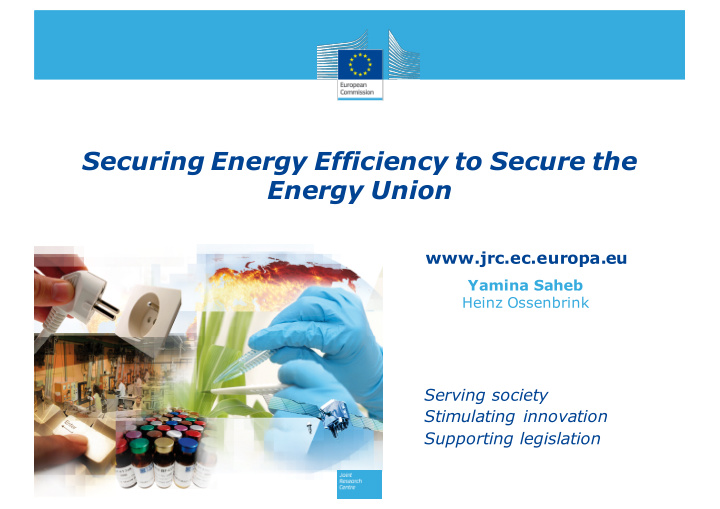



Securing Energy Efficiency to Secure the Energy Union www.jrc.ec.europa.eu Yamina Saheb Heinz Ossenbrink Serving society Stimulating innovation Supporting legislation
Does energy efficiency reduce the size of the energy trilemma? Energy security Climate change Energy affordability 2 26 th August 2015
Fossil fuels accounted for 72% of the EU primary energy mix in 2013, six percentage points less than in 1990 100% 90% 80% 70% 60% 50% 40% Fossil fuels 30% 20% 10% 0% 199019911992199319941995199619971998199920002001200220032004200520062007200820092010201120122013 Crude oil Solid Fuels Natural gas Nuclear RE Others 3 26 th August 2015 Source: EUROSTAT
EU GHG emissions decreased by 21% since 1990 but 79% of total GHG emissions were energy related in 2013 EU 2020 Climate and Energy targets Renewable Energy Directive Energy Efficiency Directive 4 26 th August 2015 Source: EUROSTAT
Transport’s GHG emissions increased over the period 1990-2013 5 Source: EUROSTAT 26 th August 2015
Domestic production of fossil fuels decreased by 16% while imports increased by 31% between 1990-2013 80% 60% 40% 20% 0% United Kingdom Bulgaria Czech Republic Ireland France Croatia Italy Lithuania Luxembourg Hungary Malta Netherlands Austria Poland Romania Slovenia Slovakia Finland Belgium Denmark Germany Estonia Greece Spain Cyprus Latvia Portugal Sweden -20% -40% -60% -80% -100% Domestic Solid fuels production Domestic Natural Gas production Domestic Crude Oil production Imports Crude Oil Imports Natural Gas Imports Solid Fuels 6 26 th August 2015 Source: EUROSTAT
Fossil fuel import bills exacerbate the trade deficits of most MSs and worsen their contribution to climate change * * Gross Inland Consumption 7 26 th August 2015 Source: EUROSTAT
EU decarbonisation scenarios and the energy trilemma • EE27: Current energy saving target set by the European Council for 2030 • EE 30: the possible energy saving target to consider when the 2030 climate and energy policy framework is reviewed in 2020 • EE40: Energy saving target as called by the European Parliament for 2030 8 26 th August 2015
Energy saving: First fuel of the EU by 2030 EE40, the sum of energy saving and renewables overtake the sum of imported fossil fuels 9 Source: PRIMES 2014 26 th August 2015
2015: Vintage year for Energy Efficiency ''It is necessary to fundamentally rethink energy efficiency and treat it as an energy source in its own right , representing the value of energy saved. As part of the market design review, the Commission will ensure that energy efficiency and demand side response can compete on equal terms with generation capacity .'' Source: A Framework Strategy for a Resilient Energy Union with a Forward-Looking Climate Change Policy Energy Union Package, COM(2015) 80 final 10 26 th August 2015
Energy dependency may reach 70% if saving potential is left untapped 80% 70% 60% 50% 40% 30% 20% 10% 0% EE27 EE30 EE40 Mitigated import dependency due to decarbonisation scenarios Fossil fuels import dependency ratio if decarbonisation scenarios are implemented 11 26 th August 2015 Source: PRIMES 2014
The transport sector is projected to have the highest share of the EU final energy consumption 100% 90% 80% 70% 60% 50% 40% 30% 20% 10% 0% 2013 EE27 EE30 EE40 Transport Residential Non-residential Industry 12 Source: PRIMES 2014 for EE scenarios Eurostat for 2013 26 th August 2015
Renewables will be the first fuel of power generation by 2030 100% 90% 80% 70% 60% 50% 40% 30% 20% 10% 0% 2013 EE27 EE30 EE40 Renewables Nuclear Solid fuels Gas Oil 13 Source: PRIMES 2014 for EE 26 th August 2015 scenarios Eurostat for 2013
4400 4100 GHG emissions reduction is 6% higher in the EE 40 Million of tonnes of CO2 equivalent (MtCO2eq.) 3800 compared to EE27 and EE30 3500 EE 40 is in the same order of magnitude than the IEA 2DS 3200 estimates for GHG emissions reduction for Europe by 2030 2900 EE 27 and EE 30 2600 EE 40 IEA 2DS 2300 14 1990 2000 2010 2020 2030 26 th August 2015 Source: PRIMES 2014
The building sector is projected to be the least emitting sector by 2030 15 26 th August 2015 Source: PRIMES 2014
An ambitious EE target would boost job creations GEM-E3 E3ME Public services (non market services) Public services (non market services) Market services Market services Transport Transport Construction Construction Utilities Utilities Engineering and transport equipment Engineering and transport equipment Basic manufacturing Basic manufacturing Extraction industries Extraction industries Agriculture Agriculture -2,00 -1,00 0,00 1,00 2,00 3,00 4,00 -10,00 -5,00 0,00 5,00 10,00 15,00 20,00 25,00 EE40 EE30 EE27 EE40 EE30 EE27 Changes in number of persons employed compared to the reference scenario 16 26 th August 2015 Source: PRIMES 2014
A guarantee fund is needed to leverage private finance and create a market for EE services 17 26 th August 2015
A long-term investment framework at the ambition level of the EU challenges is needed for… …de-risking energy efficiency investments by • providing a guarantee; …reshaping institutions and skills; • …monitoring, evaluation and enforcement of EE • policies. 18 26 th August 2015
Setting EE target should be based on costs/benefits analysis to reduce the size of the energy trilemma Energy security Climate change Energy affordability 19 26 th August 2015
Thank you for your attention To download the report: http://publications.jrc.ec.europa.eu/repository/bitstream/JRC97451/2015-12- 09%20securing%20energy%20efficient%20to%20secure%20the%20energy%20%2 0union%20online.pdf
Recommend
More recommend